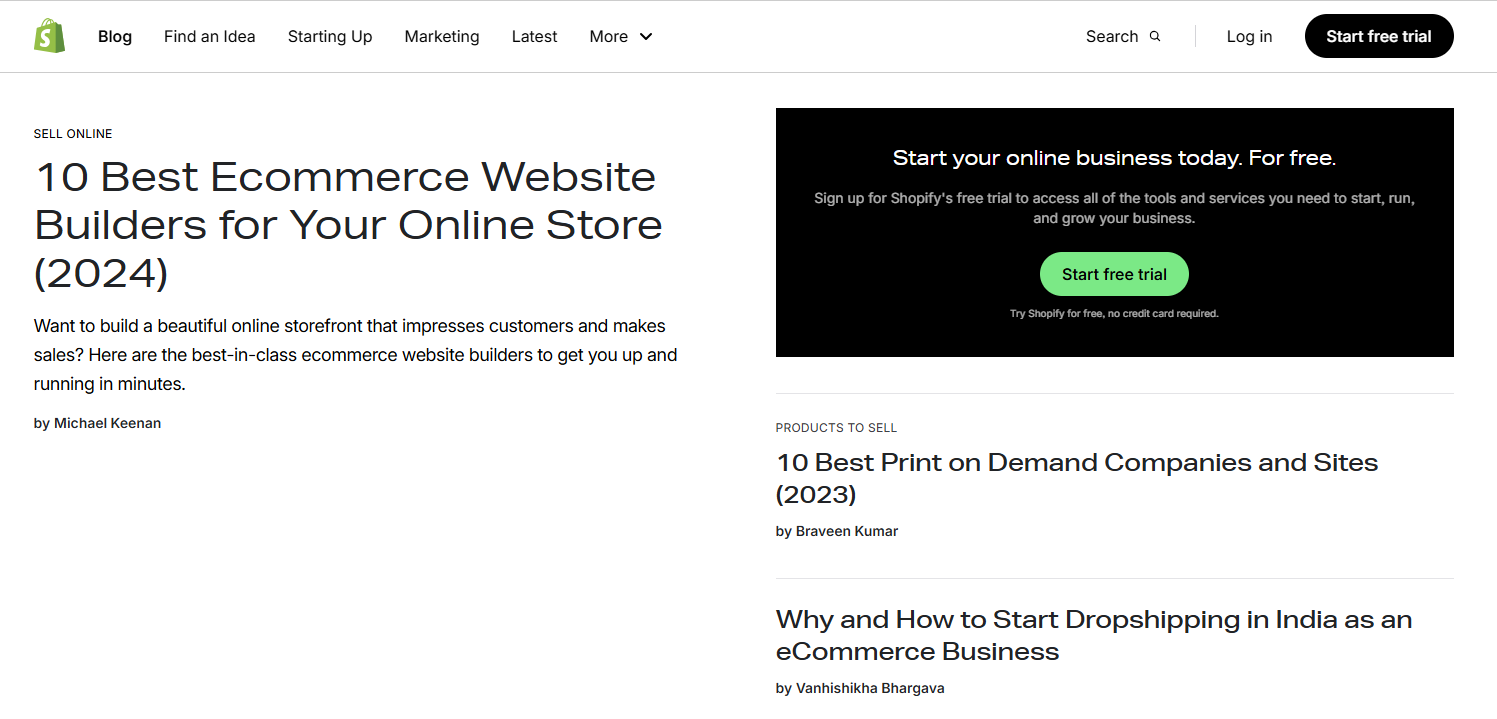Shopify SEO: Ultimate Step-by-Step Guide
Thinking of Starting an Online Store? The rise of e-commerce has made it easier than ever for people to start and grow online businesses. With more people using the internet, businesses can now reach customers worldwide without the high costs of running a physical store.
Platforms like Shopify, WooCommerce, and Adobe Commerce make setting up an online store simple. They provide easy-to-use tools to manage products, process payments, and market your business. The shift to online shopping grew even faster during the global pandemic, and this trend is still going strong.
One of the biggest e-commerce platforms is Shopify, with 4.5 million stores worldwide and 1.75 million merchants in the U.S. Even big brands like Red Bull and Netflix use Shopify to sell their products.
If you want to stand out in this growing market, SEO (Search Engine Optimization) is key. Here are some essential Shopify SEO tips to help your Shopify store attract more customers!
Why SEO Matters for Your Shopify Store:
Shopify SEO helps bring more visitors to your store without relying on paid ads. It also helps turn visitors into loyal customers. Sounds good, right?
By optimizing your Shopify store, you can stay ahead of trends like voice search and AI-driven results. The best part? You can start seeing results in just a few months!
Why Shopify SEO is Worth It:
- Rank higher in search results
- Attract buyers who are ready to shop
- Build trust and credibility for your brand
Shopify also lets you control your content and structure, making it easy to use the right keywords. Plus, it follows SEO best practices and stays updated with Google’s latest changes.
How To Do SEO on Shopify?
-
- Avoid Duplicate Pages and Content:
The duplicate page issue is common among e-commerce sites. Shopify’s ‘collections’ feature organizes your products into easy-to-view categories, but due to its structure, Shopify adds an extra URL, meaning a product can be accessible via several paths.
For example:/collections/category/product-name/products/product_name - Choose Keywords That Make Sense for Your Audience:
Choosing the right keywords is essential for your Shopify store’s success. Instead of guessing, focus on words and phrases that potential customers actually search for when looking for products like yours. Think about what they would type into Google when ready to buy.
For example, customers searching for specific products often use intent-based keywords, such as:- “Best laptop for design students”
- “Organic baby food online”
- “Affordable handmade leather wallets”
- “Free Shipping [product/brand]”
These long-tail keywords are more specific and usually have less competition, making it easier for your store to rank in search results.
- Optimize Your Metadata:
Metadata is a key part of Shopify SEO. It helps your store rank higher in search results and attracts more visitors. To get the best results, you must use relevant keywords, keep titles and descriptions clear, and make them engaging. Google also recommends using structured data in HTML for better visibility. AI can help with keyword research, but manual refinements ensure your brand voice stays consistent.
Best Practices for Metadata Optimization:- Use Keywords Naturally – Add relevant keywords without stuffing. Place the most important ones first.
- Keep Titles & Descriptions Clear – Titles should be 50-60 characters, and descriptions 150-160 characters for better readability.
- Make Descriptions Actionable – Encourage clicks with phrases like “Shop now” or “Find the best deals today.”
- Follow Google’s Guidelines – Use structured data in HTML to improve search rankings.
- Use AI, but Edit Manually – AI tools help with keywords, but refine descriptions to match your brand’s voice.
- Make Sure Your Pages Load Quickly:
A slow website drives customers away. Shopify recommends that your site loads in under 3 seconds for the best user experience. If your store is slow, Shopify provides a speed checker to analyze your website’s performance. Many factors, such as your theme, installed apps, and third-party code, can slow it down. Optimizing these elements helps improve speed, reduce bounce rates, and increase conversions.
How to Improve Shopify Page Speed:- Check Your Theme – Use a Shopify 2.0 theme for better performance.
- Remove Unnecessary Apps & Code – Too many apps and extra code slow your site.
- Enable Lazy Loading – Loads images and sections only when needed to improve speed.
- Use Next-Gen Image Formats – WEBP and AVIF reduce image size without losing quality.
- Improve Caching – Speeds up repeat visits by storing data locally.
- Follow Core Web Vitals – Metrics like LCP, FID, and CLS impact rankings and user experience.
- Don’t Neglect User Experience (UX):
User experience (UX) is key to keeping customers engaged and boosting sales. If your Shopify store is difficult to use, visitors will leave quickly, affecting both conversions and search rankings. A mobile-first design is essential since Google prioritizes mobile-friendly sites. Shopify offers responsive themes like Ubone, Lusion, and Oculus to help improve UX. Easy navigation also plays a big role in user satisfaction and SEO.
How to Improve UX on Shopify:- Use a Mobile-First Design – Choose responsive Shopify themes for a smooth mobile experience.
- Make Navigation Intuitive – Ensure customers can easily find products and browse pages.
- Optimize for All Devices – Test your site on mobile, tablet, and desktop for a seamless experience.
- Enhance Page Readability – Use clear fonts, simple layouts, and fast-loading images.
- Improve Site Speed – A faster site improves UX and boosts rankings.
- Take Advantage of the Shopify Blog Function:
Blogging is a great way to boost your Shopify store’s SEO and attract more visitors. By creating helpful content, you can target informational keywords, increase engagement, and get backlinks. This helps bring in more organic traffic, improving your store’s visibility.
Tips for Optimizing Your Shopify Blog:- Use SEO-Friendly Titles & URLs – Add keywords in titles, descriptions, and URLs for better search ranking.
- Include Images & Videos – Visual content makes blogs more engaging and helps with SEO.
- Share on Social Media – Promote your blogs on X, Facebook, and Instagram to reach more people.
- Use AI Tools – Shopify Magic autogenerates and edits blog content based on your inputs.
- Match User Intent – Write helpful content like “The Ultimate Guide to a Cozy Home” for home goods stores.
- Enhance with Plugins – Use Shopify Schema apps for better metadata and Bloggle for a search bar.
- Consider SEO Tools for Shopify:
Improving your Shopify store’s SEO doesn’t have to be difficult. There are many SEO tools available, whether you’re just starting or looking for advanced optimization. These tools help fix SEO issues, track performance, and boost rankings with minimal effort.
Best Shopify SEO Tools:- Booster SEO – Automates SEO fixes, optimizes metatags, fix broken links, and improves page speed.
- Ubersuggest – Uses AI to analyze competitors, fix SEO errors, and optimize product pages.
- Google Search Console – Tracks your blog’s performance, traffic, and SEO problems.
- Schema Markup Tools – Apps like Schema Plus for SEO help add structured data like reviews and product details.
- Backlink Monitoring – Semrush backlinks analytics and Redirect Hero help track backlinks.
- AI SEO Apps – Tools like Store Optimization SEO and ALPRank AI SEO improve rankings automatically.
- Optimize Your Shopify Site Architecture:
A well-structured Shopify store helps both customers and search engines navigate your site easily. Good site architecture improves user experience and boosts SEO rankings by making pages easier to find and index.
Best Practices for Site Structure:- Organize Products Clearly – Group products into logical categories (e.g., “Men’s Shoes > Sneakers”) so shoppers can find items faster.
- Use Breadcrumb Navigation – These clickable links (e.g., “Home > Men’s Clothing > T-Shirts”) make navigation easy and improve search engine crawling.
- Keep URLs Simple – Avoid long, complex URLs. Use short, clear URLs with keywords to improve SEO.
A well-organized Shopify store keeps customers engaged and helps your store rank higher in search results!
- Implement Structured Data for Rich Results:
Structured data (schema markup) helps search engines understand your Shopify store better. It improves visibility by showing extra details like images, prices, and availability in search results.
How to Add Structured Data Easily:- Shopify Themes – Many themes already include basic schema markup for products.
- Use Apps – Tools like SA SEO JSON-LD add structured data automatically.
- Free Generator – If needed, you can use a free schema generator to add rich results manually.
Adding structured data boosts your SEO and helps your products stand out in search results!
- Focus on Link Building for Shopify SEO:
Backlinks are important for SEO because they show search engines that your store is trustworthy and valuable. More high-quality links can improve your ranking in search results.
How to Build Links for Your Shopify Store:- Guest Blogging – Write articles for industry blogs in exchange for a link to your store.
- Influencer Collaboration – Give products to influencers and ask for reviews with links.
- Digital PR – Share infographics or e-books with journalists to get media coverage.
- Internal Linking – Connect related pages in your store to help search engines and visitors.
Conclusion:
Shopify has built-in SEO tools, but like other eCommerce platforms, it takes more effort to rank higher in search results. To succeed, use the right keywords, create helpful content, and get quality backlinks.
SEO is not a one-time task—it’s an ongoing process. By following these tips, you can make your store more visible, attract more customers, and grow your business. Stay consistent, keep learning, and see your Shopify store succeed!
- Avoid Duplicate Pages and Content:









